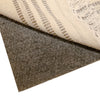Rug weaving is a prominent trade practiced throughout rural India, concentrating in the northern states of Uttar Pradesh, Rajasthan, Haryana, and Punjab.
The rug weaving industry in India is what is called a 'cottage-style industry.' These industries are defined as small-scale, labor-intensive production that can be done with simple tools owned by the craftsperson. No single person can monopolize the manufacturing process, and workers act as independent contractors.
Weavers either set up their looms at home or in central locations in the villages, and the skills are passed down from people within their community.
ARE THE WEAVERS FAIRLY COMPENSATED?
Rug weaving is considered a well-paying job in relation to the region's average income. Because weavers can build their loom and have a specialized skill set, they can choose to produce goods for the exporter who offers them the highest pay. This establishes a 'set rate' for the region, and the rate increases over time as demand remains high. Regardless of order size, the rate that a weaver receives is held to this 'set rate.' It is impossible to underpay a rug weaver as they will work for someone else.
Weavers are paid per square foot and earn different rates based on the complexity of the design. 'Master weavers' make the highest rate as they can quickly deliver high-quality rugs and train other weavers.
WHAT ARE THE WORKING CONDITIONS LIKE
Many weavers choose to set up in their own homes. Still, many looms are set up in more central locations in the open air, with a roof over the loom to give shade and keep the rain off during the monsoon. The weavers set their hours and choose how many rugs they want to produce.
ARE THE RUGS FAIR TRADE?
Neither Mark Krebs nor any of our export partners in India are affiliated with the fair-trade organization. As the business grows, we will investigate different certifications and work with our rug weavers to complete these certifications. This is a great way to show further transparency.
The focus of Mark Krebs is to bring awareness to the manufacturing process and make sure the process of making is part of our brand identity. This type of transparency is critical for telling the true story of the life of everyday things.













